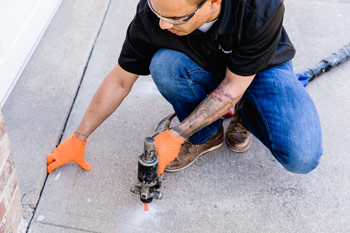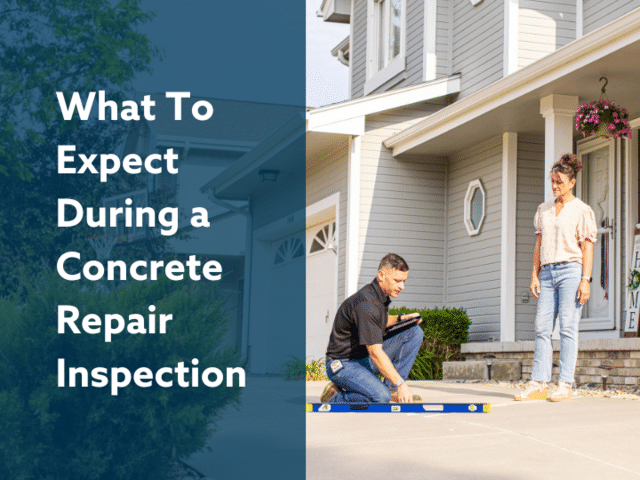Mudjacking vs. PolyLevel Foam Jacking: What's More Effective?

Concrete repair and Foundation crack repair is a hands-on specialty service from Thrasher.
Your home's concrete -- its patio, pool deck, sidewalk, and, especially, its driveway -- is its calling card. It's among the first things visitors notice as they approach your home, and it's likely the first thing they'll notice if it's not in the best condition. It's no wonder that we as homeowners want to keep our concrete looking in tip-top shape. Often, homeowners debate the options of concrete replacement and concrete repair, but there's more to consider, including which concrete repair method is best. Oh, and while we are on the topic, let us also not forget about foundation crack repair. Maybe not as visible as the above, but a cracked foundation can carry serious implications for your home.
Mudjacking is a well-known solution for lifting uneven concrete slabs or concrete patio stairways back to level, but more recent technology utilizing polyurethane foam rather than a mud-cement-slurry mixture brings about the question: what's more effective? Below, we'll get into the details of mudjacking versus PolyLevel foam jacking.
Why Concrete Needs Maintenance and Repair

Whether you need repair to the foundation cracks beneath your home, or concrete repair around your home, Thrasher are the local experts on both.
Actually, before we talk about concrete leveling and lifting, let's take a few moments to understand why concrete slabs sink in the first place. Concrete is strong, durable stuff, but it's only as stable as the soil that lies underneath it. Over time, that soil can compact or even wash away due to several factors, including rain, drought, or simply the fact that the fill soil deposited there when your home was built wasn't compacted well.
When the soil beneath your concrete compacts or washes out, it leaves voids into which heavy concrete slabs sink. These voids need to be filled in order to raise the sunken slabs back to level. It's at this point that we're faced with a choice of which method to use: mudjacking or PolyLevel polyurethane foam jacking.
Concrete Lifting With Mudjacking
At first blush, mudjacking seems like a pragmatic approach. After all, if the soil has compacted or washed away underneath your concrete, doesn't it make sense to put more soil -- or a soil-like slurry of mud and/or cement -- under your slabs to replace it? It's not a bad idea in theory... but in practice, it can have several drawbacks.
Messy and Disruptive
The first drawback is right in the name: mud. Mud is dirty. And mudjacking is a dirty business.
In addition to being dirty, mud is, by definition, wet because it contains a lot of water. It's what allows mudjacking contractors to pump it under your concrete slabs. But, just as with regular mud, when it dries, it shrinks as space once occupied by water becomes empty. This means that your slabs could sink back down again, sending you right back to square one. But that's not all. What happens to dried dirt when it gets wet again? It turns right back into mud. Unless your concrete's joints and cracks are perfectly sealed, water can run underneath, turning that dry material right back to mud that can wash out, once again leaving you with voids into which your concrete can settle.
And, mudjacking slurry is messy when it shoots out from beneath the slab under pressure. Will you trust your contractor to clean up all the spattered mud when they're done? Many don't.
Larger Port Size
The second main drawback is aesthetic, but it's no less important. In order to pump the mudjacking slurry underneath your concrete, the contractor will have to drill a series of large ports into your slabs. These need to be wide enough -- at least 2" in diameter in most cases -- so they don't restrict the flow of the material. When the job is done, these ports are filled in. As it is virtually impossible to match this fill material with your original concrete, these ports will leave your driveway, patio, or pool deck with a strange polka-dot appearance. Wasn't improving your home's appearance one of the main reasons you decided to repair your concrete in the first place?
Doesn't Address the Underlying Issue
But, the major problem with mudjacking is that it doesn't address the reason your concrete settled in the first place. Remember how we talked about poorly compacted soil compressing and causing your heavy concrete slabs to sink? Well, what do you think will happen when thousands of pounds of mudjacking slurry is pumped underneath them? That's right; you've just compounded your problem by adding more weight on top of this unstable soil. This can cause your driveway, patio, or pool deck to sink even more!
As you might guess, we think there's a better way to lift and level your sunken concrete slabs.
Concrete Lifting With PolyLevel(TM) Expanding Polyurethane Foam
At Thrasher, we've got a lot of experience with concrete lifting and leveling. After all, we've been doing it for decades. In fact, we used to offer mudjacking services to our customers. But, all that time, and for all the reasons listed above, we just knew there had to be a better way. It turns out there is, and the answer isn't mud, it's foam. PolyLevel polyurethane expanding foam, to be exact. You may have heard it referred to as polyjacking or foam jacking, or polyurethane concrete lifting.
Smaller Port Size and Quick Curing
PolyLevel is a lightweight, strong high-density polyurethane foam, developed by our sister company Supportworks and only available to an exclusive network of foundation crack repair and concrete repair contractors. It's pumped beneath concrete slabs through tiny ports about the size of a penny. Initially, Polylevel flows like water, filling even the smallest cracks and crevices in the soil. It quickly expands and hardens, lifting the concrete slabs above it and compressing the soil around it at the same time. Polylevel is waterproof, so it will never wash out, and it won't degrade over time due to temperature extremes. Best of all, Polylevel cures quickly, allowing your concrete to be used normally the same day.
Addresses the Underlying Issue: Stability
Concrete lifting with PolyLevel expanding foam not only raises concrete slabs, but also compacts the soil around it, creating a stable environment that will ensure that your driveway, patio, or pool deck remains level into the foreseeable future. Did we mention that it's environmentally friendly too? Because it won't degrade over time, it won't leach harmful chemicals into the surrounding soils.
Final Recap: Mudjacking vs. PolyLevel Polyurethane Concrete Lifting
The bottom line is when you're considering mudjacking or PolyLevel polyjacking... well, there really is no comparison -- even when it comes to price. Mudjacking is sometimes less expensive initially. But since it can cause your concrete to sink and settle further over time, you're likely going to have to pay to have it lifted over and over. Wouldn't you rather just have it done once and never have to think about it again? So, let's recap:
Mudjacking is messy, ugly and may make the problem worse. Concrete lifting with expanding PolyLevel foam is clean, aesthetically pleasing, and addresses the underlying problems that caused your concrete to sink in the first place.
Contact Us for a FREE, No-Obligation Inspection
If you're ready to lift and level your driveway, patio, or pool deck in Nebraska, Kansas, Western Iowa, or Northwest Missouri, give us a call and schedule a consultation with Thrasher, experts in concrete repair and foundation crack repair before the damage gets worse.
Article Categories:



